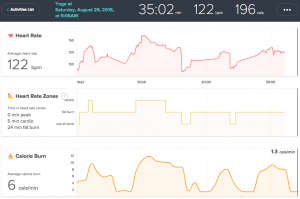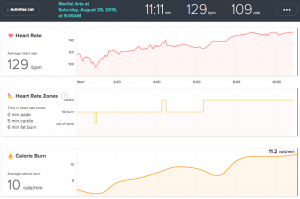Several months ago, I made what I considered to be a startling discovery: I am consistently in my fat-burning zone when I do Chinese martial arts forms.
To put that into perspective, my heart rate is usually 10-20 beats per minute higher doing martial arts than it is doing DDPYoga. I do DDPYoga to burn fat and to build muscle, so imagine my surprise when I noticed that martial arts get my heart pumping faster than a program that touts itself for its heart-rate-jacking, fat-blasting workouts. (See my experience with using the Fitbit Charge HR for DDPYoga here.)
I’m not knocking DDPYoga here. In fact, as I write this, I’m just a few hours short of acquiring the teaching hours I need to become certified.
What I’m saying is that Chinese martial arts have almost a stigma attached to them. Many consider them to be just a way for old people to stay healthy as they age. And yes, while that’s true, it’s only one aspect.
Chinese martial arts help people burn fat.
I’ve experimented a few ways – doing my tai chi chuan form and Hsing-i forms without any other workout for the day, doing those forms after DDPYoga workouts ranging in length from 20 to 40 to 60 minutes (which is usually my favorite) – and the bottom line is that Chinese martial arts raise your heart rate and allow you to get into your fat-burning zone.
Let’s take this morning, for example.

I started off doing the DDPYoga Mix Tape routine – one of the most challenging 35 minutes in that set. I was able to raise my heart rate quicker than I’m usually able to, shooting up into the 120s fairly early. (Remember, my fat-burning zone is 134-154.) I peaked in the workout at 159, and you can easily see from my chart that I backed off pretty quickly. Overall, I stayed at 122 average beats per minute.
It should be noted here that it’s hard for me to get in my fat-burning zone. Even when I’m putting all my energy into it, I’ll still see myself in the 120s, about 10 clicks below where I should be.
This might have to do with the placement of my Fitbit Charge HR. It needs to be placed on my wrist just right. I usually wear mine so that the sensor is on the top of my wrist, but for working out, I’ve found it works better when I turn it inside. If it wobbles from punching or it slides from sweating, I can see myself going down 30 bpm. Literally. So, I may be in my FBZ without even knowing it sometimes.

After I finished that, I went to go do my tai chi chuan form outside in the park since it was nice out this morning. That took me about 5 minutes. I followed that with the five Hsing-i chuan element forms and the four animal forms I know so far. Even though I was only working out about a third of the time with martial arts, this chart looks like I’m staying in my target zone longer. It’s been that way on other workouts, too – I’m consistently noticing myself in the 130-150 range.
The kicker here is that I don’t feel like I work as hard at Chinese martial arts as I do at DDPYoga. That’s usually the reason why I do it at the end of my workout, so I can cool down. With DDPYoga, I’m drenched at the end of the workout, “sweatin’ and swearin’,” so to speak. But with martial arts, what I feel like would be a “light” workout can still put me in my zone.
So, if you’re looking to complement your main exercise program, think about martial arts. In addition to all of the great values martial arts teaches, they’re also a fully capable weight-loss and muscle-building system.
If anybody has any heart rate advice related to martial arts, please comment.